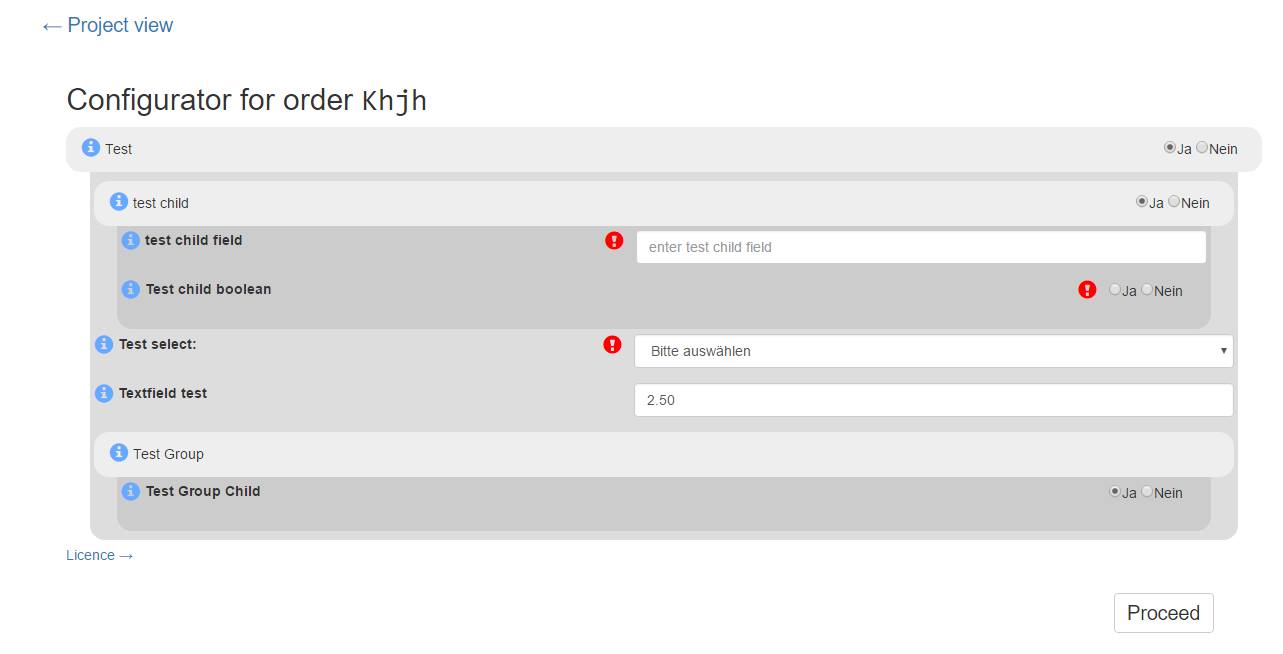This Monday we kept our final presentations for Company at their offices, first for the Finnish team and later also for the Austrian team. They appeared to be very satisfied with the finished prototype, and would consider assigning resources for its future development. They especially valued the fact that our prototype already is live and can be easily accessed online, so that they can have their customers and salespeople try it out without any additional effort from their side. They also liked the modularity of the prototype, which means that they easily can customize it to the different needs for different regions.
On Friday, all of us gathered in the undergraduate centre at 9 o'clock in the morning to set up our stand for the grande finale. Today, we are going to present the final version of what we have achieved in our project. Our stand consisted of a poster visualizing the concept, and a laptop, on which we demonstrated the configurator prototype.
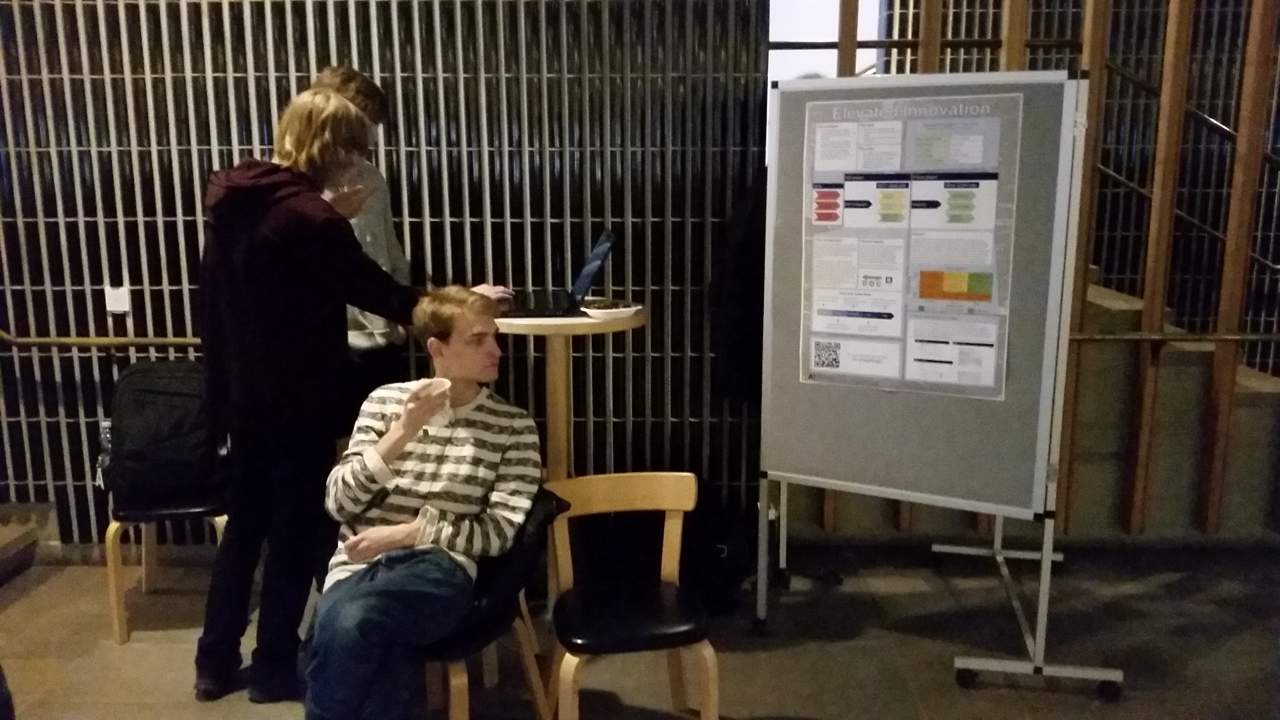
When all the stands were ready, every group presented their project in a three minute time slot on the "stage". We had decided to do a one man presentation, based on the feedback we got at the rehearsal last time. This time the presentation went really good, and we hope everyone got a clear picture of what we have done.
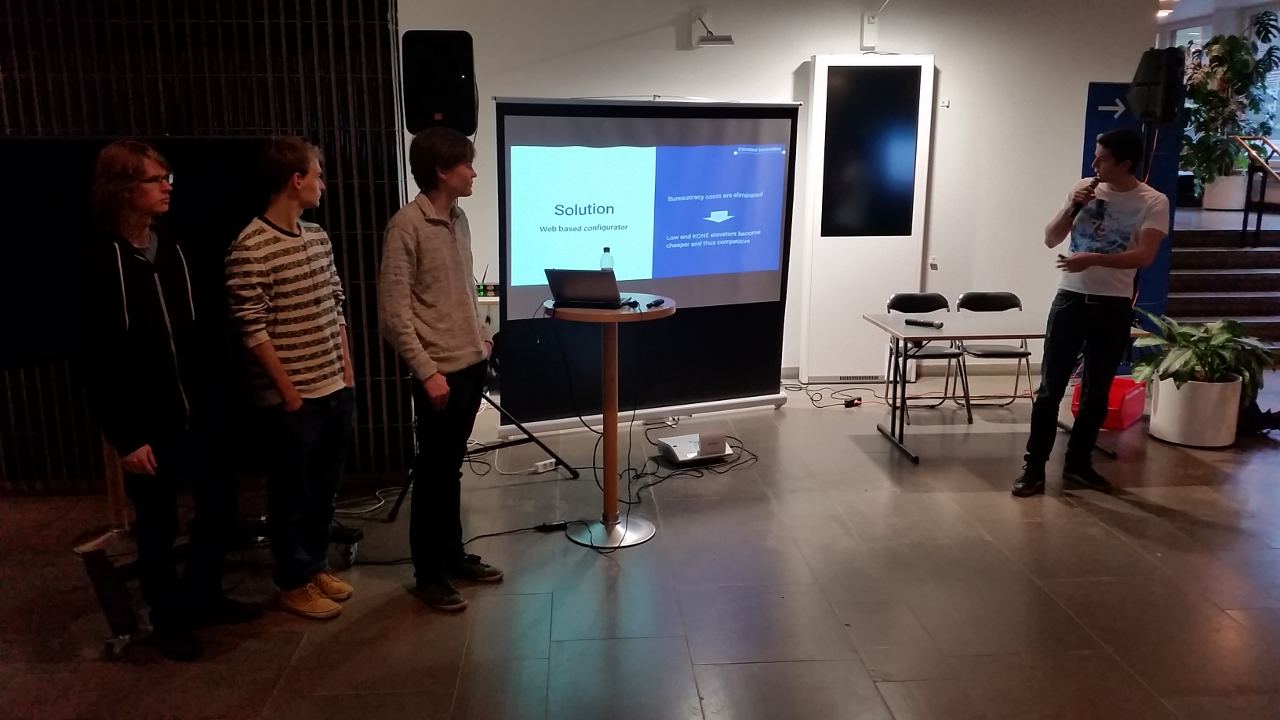
After the presentations, there was some time left to walk around and take a look at the other stands. The energy was great with all groups showing their project outcomes, and there were lots of inspiring ones to get familiar with. Interested people came to see us and ask more at our stand, not only from the course but also other people walking by.
Our next task will be to present our project to Company on Monday. We are going to base the presentation on the 3 minute version we made for the Grande finale, but as we have 20 minutes instead of three, we will talk about it on a much more detailed level and involve more than just one speaker. We are also going to tell them more about the technical aspects of the prototype and discuss possible next steps.
We have come pretty far with our project, and we're very pleased to have a working prototype constructed. However, it's not a final product, but more of a prototype for proving the concept. We have also been doing some planning and thinking about how the product ideally should work, and what future potential it has in a real business environment.
When we are finished, and have presented our work to the Company team, they are going to evaluate whether it's a direction in which they want to go further. If they decide it's a no-go, at least we hope they will have a broader view of what is possible and what the future might bring. However, what we hope is obviously that they will go on with the project with own resources, and use our work to improve their sales process. In that case, they have lots of work and decisions ahead.
One of the most important things that need to be done is the integration to back-end production systems. Currently, we have integrated the customer in the process and made it possible for salespeople to manage multiple projects in a simple way via the admin view. But after the order is placed, the process hasn't changed a lot. By automating the ordering production process inside of the company as well (as opposed to the customer facing part of it), Company could further reduce fixed costs and allow the sales team to perform more productive tasks, instead of spending time on mechanical processes. The payment process could also be developed, the legal issues turned out to be too extensive for us to tackle in this project.
This is how we think the sales process for our targeted customer segment should work by the end of 2017: The customer, let's call him Fritzl, who already has done some business with Company earlier, goes to the configurator and logs in with his credentials provided by his Company contact person. Fritzl knows what he wants, and it's actually quite similar to what he ordered for his last project, so he goes ahead and opens a clone of his last order in a new project-view. He's not quite sure about a couple of details, so he calls his contact person, who briefly goes through the configuration and checks that everything is allright. After that, Fritzl is so pleased with how simple and fast this was, that he doesn't even bother to compare it to competing alternatives. He knows what the price consists of, and trusts that it is justified, so he goes ahead and places the order. Now, the configurator passes on all the information to the inside systems at company, and the order starts its journey towards production. Fritzl is happy with how little time he spent, and he is already looking forward to the next meeting with the board, where he will tell them about how efficiently he is moving forward in his project.
There is, however, limitations to what can be done to the sales process in means of simplification. After all, there is a very simple reason for why ordering an elevator currently can be perceived as a messy and complex process: It's a complex product. Buildings do not have standardized shaft sizes, regulation brings lot's of bureaucracy, and it all needs to be done right the first time. There is no room for errors. Realizing that the elevator won't fit in the customer's building after it has been produced, approved and shipped cross borders would be a nightmare for Company. Not only because of the huge excessive costs, but also because of brand damage. Thus, the salespeople still need to make sure that every ordered elevator is 100% what the customer needs it to be.
The course is coming to a close and we have been hard at work making our tool function as well as possible. We have been working on new features such as PDF generation based on the user’s input and a second configurator, whose selected options will determine whether or not the customer should be Elevator Model X or something else. The generated PDF-file will ultimately be the bridge that tells a salesperson what options a customer has selected in the configurator. Based on these values the salesperson can input it into Company’s system and send the elevator into production. In a non-prototype version this step would be dealt with automatically.
Security, integrity and modularity have been a major part of our project. In the final version of our prototype we have made sure that Company will be able to maintain and extend the tool if they decide to do so. We have performed tests to make sure that users will not break anything accidentally or purposefully. Our custom server-side data validator checks that the information filled into the forms is acceptable. If the data is invalid, the configurator will tell the user what input is invalid and how to correct it. We have also made the configurator cleaner and easier to use for admins.
In addition to working on the tool, we have been preparing for the Grande Finale event this Friday. Today, our poster for the Grande Finale was sent to be printed. We hope the attendants will find it intriguing and interesting. There are still some minor preparations and rehearsals we need to do before Friday but otherwise we are ready for the event. We are excited to reveal our final result to the public! Hope to see you there!
We have been working on this product since September and we finally have the opportunity to let you experience it yourselves. We invite you to the course’s Grande Finale event. At the event you will also be able to talk with us and provide feedback on our work. In case you are unfamiliar with our work, we are working on an order processor/configurator.
Let’s now take a trip down memory lane and look at all the accomplishments we have made.
In our first blog post we were preparing for our first meeting with our client. The project topic at this point was still a little bit unclear.
In the second blog post we reveal which topic we chose. The topic was not refined at this point as you might notice reading this post.
From our value proposition canvas post you will notice that the topic has been much more refined and we have a clearer understanding of what we are making. This post should also convince you why our product is appealing to our company.
When we got our first version of the configurator, we were very happy to share it with the world. Although we knew we had a lot of work remaining.
Approximately two weeks later, we had managed to create a new version of our product that had many more features. Our company was very happy with the progress that we had made. If you need more convincing of our product’s usefulness, read the Revenue Model and Business Case post.
We are currently making the final touches to our product and we will soon have more progress to share. Stay tuned for future blog posts!
Earlier, we assessed the business potential of our project by using the Value Proposition Canvas to sketch up what problems we are solving and who our customers are. Next, it's time to take a closer look at how the business would look in terms of business model and revenue streams. For the business model evaluation, we used the Business Model Canvas (BMC). We also created a revenue model using "Business model blocks" by Innovation Board. Because of confidentiality, we agreed with Stina that will not analyze time saved by salespersons, but instead focus on descriptions of the revenue model and BMC. Here are the two models we created and a quick explanation of them both:

BMC:
The BMC breaks down the business model into parts, including key resources, revenue streams, customer relationships etc. The value propositions and customer segments, which we examined more closely in the Value Proposition Canvas, are also a part of the BMC. The fact that we are creating a tool inside a company to make the sales process better is a bit tricky when it comes to creating a business model, but thinking of our project as a business is still a good way to evaluate it and get a grip of the project as a whole.
Looking at the BMC, we see that the customer relationships are very important. This is of course is quite logical as we are working on a sales tool. In this part of the BMC, we'll have to put our trust in the sales department, and hope they do a great job of connecting with the customers. However, one of our value propositions, that also help build customer relationships, is that the customer is able to save a template for a specific configuration in order to make it easier to make a repeated similar purchase. We also think that the simple user interface will do a great job in reducing friction between the customer and the company.
Our tool will require almost no costs except for the development that we are doing. There will be some updating and maintenance along the way, but the existing IT department can easily take care of that without much extra effort, so it doesn't require new recruitment. We will make the tool modular so that it's easy to expand and update.
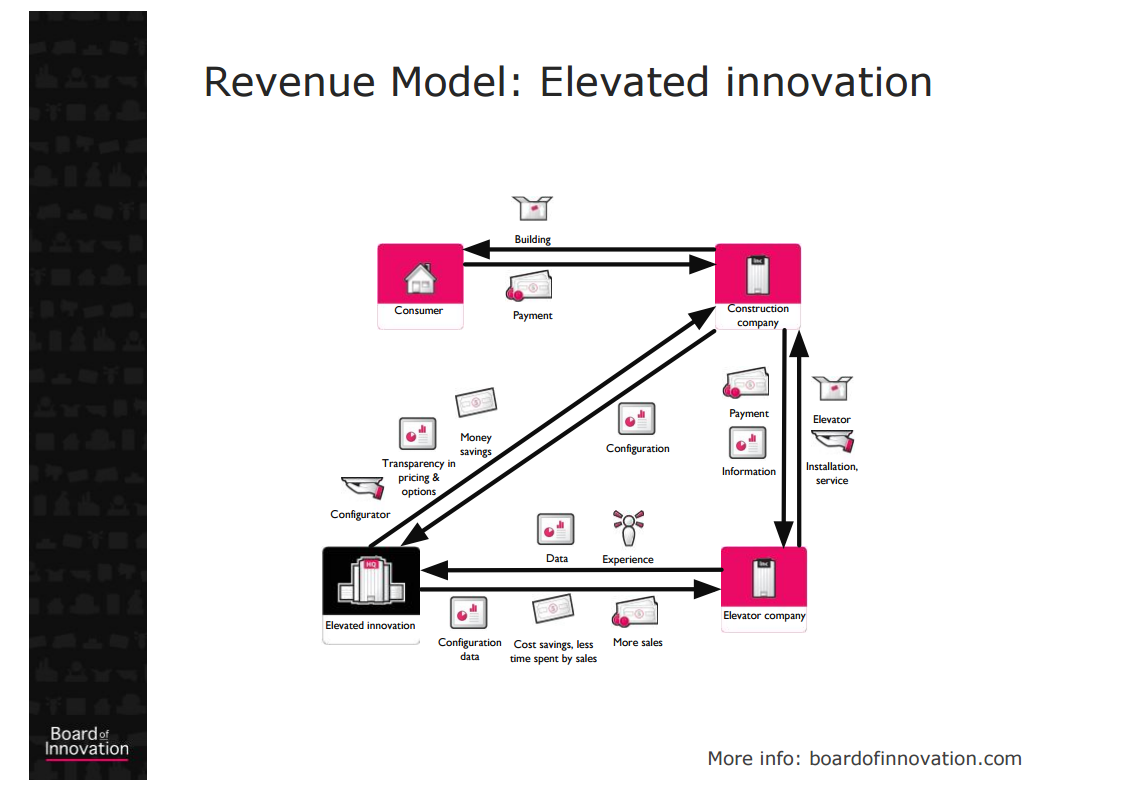
Revenue Model:
The revenue model that we created consists of four different players and different objects exchanged between them. The end consumer doesn't really affect our tool, but is still seeing the results of it as an elevator in their building, built by the Construction company who bought the elevator from our company, using our tool. The process starts with the Construction company reaching out to the Elevator company, expressing an interest to buy an elevator that is as cheap as possible. This is marked as the flow of information in the model. The elevator company then uses our tool to give the construction company the possibility to configure an elevator that fits their needs, possibly copying an order they have made earlier. Using the configurator, they are able to compare different extra features and services that our company normally include in a purchase, and leave them out if they don't think they add enough extra value. For instance, the construction company can choose to take care of some required documentation themselves if they have the knowledge and experience required, and thereby reduce total costs of their project.
Using the admin-view of our configurator, the salespeople then see that the construction company has completed a configuration. The deal can then be closed, and the process towards delivery can start. Finally, our company provides the construction company with the elevator they purchased, and gets payed for it. The timed saved by the configurator can be used for more productive activities, so the efficiency of the sales team will increase. Making repeated purchases is easier for construction companies, and our elevator company will hopefully get some additional market share from other elevator companies because of this attractive feature.
After the customer has placed an order, there are lots of more processes leading to the delivery and installation of the elevator. There is a lot of potential for saving time here as well, and we have discussed several aspects and ideas with the sales team. However, we will keep a more narrow scope in this project and make the configurator work until the order (or the "expression of interest", not binding), and let the company decide if they want to expand it after testing.
Even though the revenues are a bit tricky to predict and measure, we definitely think that this is a project worth finishing. We base this on multiple conversations with the Austrian sales team, who has the closest connections to our customer segment and the best understanding of their needs. The sales process itself also has a need for more efficient tools. Keeping the low costs in mind, there is not much to loose on testing the tool. Based on the real test uses, we will see how it works and what needs to be changed. The tool needs to be in really good shape before that, as the company has a strong brand that they want to protect.
Today we had a 3 minute presentation for the course, where we briefly presented our progress with our configurator prototype. The presentation went quite well but, as you can see from the video, it could probably have been improved by preparing even better. We definitely should have spent more time on the visual aspects of our slides, which also were pointed out to us in Presemo, and maybe considered leaving out the demo of our tool. Fitting a demo in a three-minute-long presentation is challenging and something we will avoid in the future. Using screenshots should also make the presentation more fluid. However, we believe that we will, with a little more energy and additional experience, have a great final presentation.

Since our last blog post we have been developing on the prototype of the web configurator all week. From previously being a simple static HTML page, it now features a great dynamic backend that we wrote in Django. Creating the prototype was not that straight forward though, as we especially encountered obstacles when trying to upload it to a public server. For the hosting we chose Heroku, which seems to be quite picky about everything being set up exactly the right way.
We have tried to make the prototype modular. This means that all the parameters for the configurator are taken from a database, so that parameters easily can be added or removed as our client requires. Below you find some screenshots of the current state of the prototype. As you can see, the layout of the configurator has changed quite a bit from the last screenshot we posted. From the user’s perspective, this change will hopefully make the configurator more straight forward to use.
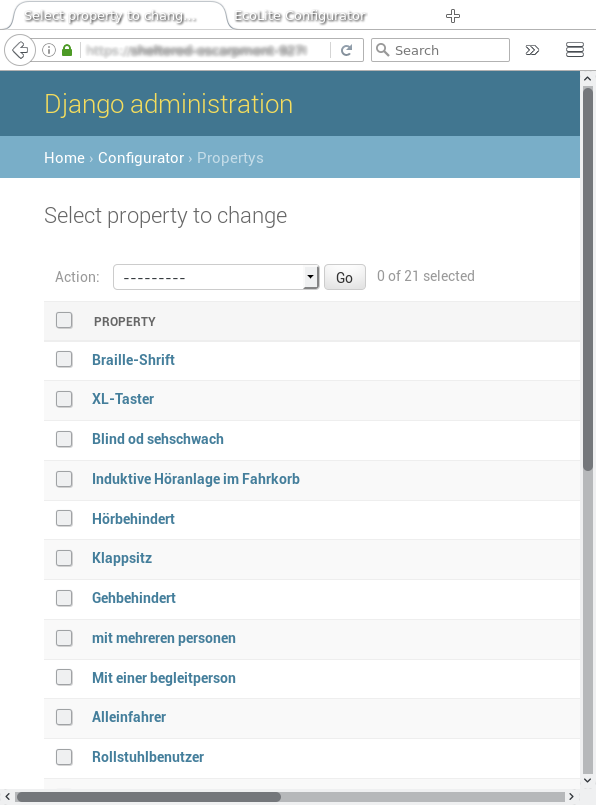
The administration view of the database, where the client can add the properties that the customer has to choose.
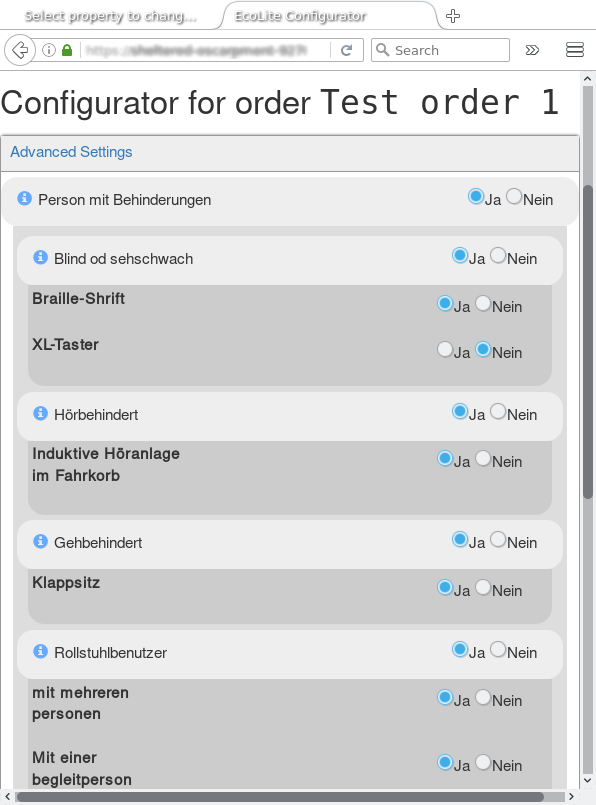
The options the customer can choose from when ordering the product.
- Johan
This week we have had major progress in our development. The IT-oriented of us gathered yet again to produce line after line of code for our web service. The developing was swift and agile, we tried several approaches, quickly scrapping ineffective ideas to make room for better ones. Building on what we had achieved last week, we now have a full-fledged database system capable of localizations, users-accounts with project management and user specific defaults. We have been using Django (python) to accomplish our webservice. We chose Django because some of us were familiar with it from a computer course they had recently had. Another alternative would have been C# with ASP.NET MVC, but we only had one person with experience in it. Coding Django with Jon and Johan has been a great learning experience for us who had not used it before.
We had a meeting with the Austrian team on last friday (11.11.2016). They were pleased with the progress we had made and we decided to have a public (limited access) version of our prototype available for them to test for next (this) friday. We have managed to meet that schedule, as we now indeed have a public version up and running.
-Max
Once again, we gathered with the whole team for a hackathon to get our prototype in shape for tomorrow’s meeting with the company, where we will demonstrate the architecture and basic functions of our product to the Austrian representatives. We wanted to have it as far developed as possible to get the most out of the meeting and to be able to get accurate and valuable feedback.
We analyzed further what information exactly we would like to collect from the customer, based on a checklist sheet used in Austria. The German language did pose a challenge, but luckily we didn’t have to rely only on translation websites. One of our group members understands German well enough to get the important facts from the context.
On the software development side, we created a back-end for our site and implemented a login system. We also improved our configurator.
With this done, we feel confident that we will have a good meeting and get some new things to work on. Additionally, we are going to have to start thinking about the business potential of our project, as the next deadline is approaching. We have already covered it to some extent in the beginning of the project and when we were working on the value proposition, but we need to continue working on it to get a good presentation for next Friday.
Now that we have received a brief description of the product that our company would like us to develop, we decided to immerse ourselves in some proper coding sessions. The coders among us were eager to get their hands dirty with the actual product.
Since we only had a brief description of the product to go on, we decided to start by developing the frontend side as a webpage with options for the customer to select as well as information regarding the different options, and the calculated total price of the elevator. From a technical point of view, this is a rather straight-forward thing to do, but we had to develop it while keeping in mind that it will have to be combined with a proper backend system in the near future.
After the first pair programming session, we had a first version of this front-end part ready for the rest of the group to review and keep building on. Our group's physicist rewrote the form logic to be more compatible with future backend services and we all added and changed various features. Much remains to be decided regarding the final functionality and layout, but the current version constitutes an excellent base for us to keep building on, depending on what new information we obtain through our meetings with the company representatives.
- Jon
As the project has now been going on for a while, our scope has changed a bit from what we originally thought it would be. First, we were targeting small firms, who do not use Company at all yet. Our task was to open up a new market by introducing them to Company in a simple, understandable way that would remove the fear of a big corporation.
However, as it turns out, this is not the case. Our customers are now instead specified as major contractors, hand picked from the Austrian market. These customers are usually personified by project managers, who either have a background in electrical engineering or the construction field. They are technical engineers, so they do have some knowledge of elevators and their requirements. They’ve already used Company elevators to some extent, but they also use competitors products, mostly due to cheaper alternatives being available. They are the ones who decide which elevator to go for in different projects, and the number one thing that they are looking at is price. Effort is another thing they are trying to minimize. With this in mind, we think that we definitely can get some additional market share by providing a tool for clearer and more efficient communication of low prices.
We think about these project organizations as our main customer, but one could also argue that Company is our customer, as we are doing this project for them. After all, we are definitely trying to improve the performance of the sales team. If we succeed in creating this configurator, we will satisfy both of our customers very well. That’s why we have split our customer segment in two parts; one for Company and one for their customers. We also split the Gain creators and Pain relievers in a similar way.
Regarding our product, the plan for the configurator itself will remain the same in most aspects. However, it will differ in one big way from our original vision; At first, we thought about designing an online configurator open for the public, but now we are planning one that is only accessible by Company-provided credentials. The biggest reason for this is that we do not want to cause any cannibalism within Company’s other products. If we would make ordering cheap Product products too accessible and easy, we might lose sales in the more expensive product segments, as project managers often want to cut all costs that they can (while also minimizing their effort). At the end of the day, we are all just human beings, acting rather predictably.
Our product is designed to enhance the sales process with customers that already know what they want. These are the project managers of the big contractors, as we mentioned above. The process, in a nutshell, starts when a contact person from Company recognizes an opportunity to sell Product instead of a competing product by another maker, and gives the customer credentials to our web-based configurator. The idea is that the customer is then able to check boxes and choose alternatives that give Company a clear understanding of what product specifications he would need. If the customer needs additional guidance, his contact person from Company is happy to help him by phone. This way, the sales organization can focus more of their time on doing important work, instead of doing all the configuration work for the customer in a non-efficient way. In addition to saving Company precious time, our configurator is also meant to create extra value for the customer, as it is fast, easy to use, transparent and provides the alternative that they really need (and nothing more).
To make the Value Proposition canvas as clear as possible, we decided to present it in a text form instead of the conventional post-it kind of visualization. The fact that we want to divide our customer segment in two different customers also supports this decision.
Customers: Company Sales
Jobs:
-Sell elevators
-Maximize own profit by bonuses
-Enjoy work, do fun and meaningful things
-Succeed in career
-Bring success to Company, profitable sales
-Communicate with customers and present products alternatives
-Negotiate prices
-Make customers as happy and comfortable as possible
-Build trust with customers
-Keep existing customers coming back for more
-Get new customers
Gains:
-Sell elevators effortlessly, no extra processes.
-More time to do productive things (maximize bonuses)
-Feeling of productiveness and acceptance, being valuable to the firm
-Sell more
-Close deals faster
-Being able to use clear tools to communicate with customers
-Streamlined, easy to visualize process
Pains:
-Not enough incentives to really make it worth the time spent trying to sell Product
-Too much time spent on other things than core selling.
-Customer not aware of offerings, so has to be educated by sales over and over again
-Misunderstandings in communication
-Old customers do not have an easy way of getting what they already know they want, means repetitive work for sales.
-No clear way of communicating low prices (without services included for instance)
-Finding new customers
-Hard efforts and great customer service not recognized in KPIs
Jobs:
-Lead building project
-Minimize project costs! Important
-Get an overview of the elevator market
-Find the best elevator for their project
-Understand how pricing works, services etc.
-Minimize time spent on finding and buying an elevator
-Communicate needs for the building to get a correct elevator.
Gains:
-Good customer service, easy to understand sales process
-Fast service
-Few process phases, straight to the point with no unnecessary paperwork
-Ability to purchase what they already know from experience that they want, with no extra effort
-Getting exactly the product they need
-Being able to compare costs easily
-Need for less knowledge
-Respect from board and co-workers
-Increased safety, reduced risk
Pains:
-Market visibility bad, hard to get a grip of what options they have
-Impossible to investigate all options with limited time
-Process slow and tacky, not straightforward
-Very technical terms, hard to filtrate relevant specs
-Hard to know who to trust
-Prices sometimes include different services and so on, hard to compare true costs.
-No easier “shortcut” way of getting what they know they want, time spent on purchase always the same.
-Pricey elevators
Product
Products & Services:
-Web portal with configurator for Product
-Ability to get a bare-bone version and add features/services to that base
-Limited access – only hand picked customers get login credentials
-Sales contact involved, helping customer if needed
-Non-technical questions outlining customer needs without involving him/her in too difficult questions about specifications
-Also compatible with older versions of the most common web-browsers
Gain Creators:
Customer:
-More visibility helps to understand what the price consists of
-No need to pay for extra – only pay for the essentials they really need
-Easy to use software, also aesthetic (after prototype phase).
-Easier and faster process
-Better service
-Improved result in less time
Company Sales:
-More time available for finding new customers and doing important closing work instead of mechanical work
-KPIs and bonuses easier to reach as time is used more efficiently
-Self-satisfaction improves as performance improves and gets recognized
-Clarity in the process
-Visibility and honesty generates trust
-Potentially more elevator sales as base price becomes more competitive
-Sales process gets faster - better performance and customer satisfaction
Pain Relievers:
Customers:
-Less need for research and slow communication
-More streamlined process with less pit stops taking time
-Easier to understand and formulate needs
-Less time needed for exploring Company options
-No need to go through same process as last time if similar need. Shortcut!
-Cheaper versions available
-True costs easier to visualize, understand what they get for the money
-Less technical knowledge needed
Company Sales:
-Less configuration work and communication required, clearer communication
-Less time spent educating customers, more available for real selling
-Less time spent on repetitive work, and less frustration associated with that
-Easier to explain what the price consists of and point out the value that the customer gets
-Time freed up can be used to find new leads and expand business.
-KPIs and actual performance more in line
In this blog post, we will discuss what plans we have in mind for the future regarding the project, as well as some clarification about the distribution of tasks between the group members. Additionally, we will provide a draft of the individual time use that we have logged thus far.
Our project is about increasing elevator sales for our company.
Specifically, we will analyze and target smaller construction companies.
This might involve creating an interactive configuration tool to aid the sales to these companies,
which presently tend to prefer dealing with other small companies for all their elevator deals.
The interactive tool could attract new customers and allow the company to sell more while demanding little effort from the sales team.
In addition, the tool would help customers visualize the product and configure it to their needs.
Circumstances dictated that Max be our group leader,
with Rolf as the presiding economist, Jonathan as the 3D/VR expert,
Jon as webmaster and Johan as web technology virtuoso.
Max, Jon, Jonathan and Johan will primarily focus on creating the required technology.
Rolf and Max will mostly handle our customers.
Rolf will also sharpen our strategy and market research.
From the table underneath you can see how we have predicted our time usage.
We expect to spend most of our time on product development, managing the blog and market research.
| Time Use | Max C. | Rolf K. | Jon G. | Johan R. | Jonathan G. |
| Course events | 15/30 | 15/30 | 15/30 | 15/30 | 15/30 |
| Meetings with the company | 3/25 | 3/20 | 0/20 | 0/20 | 3/25 |
| Planning in team | 10/35 | 10/35 | 10/35 | 10/35 | 10/35 |
| Blog Framework | 4/8 | 0/0 | 5/12 | 3/12 | 2/8 |
| Blog Writing | 3/4 | 2/8 | 1/4 | 1/4 | 2/4 |
| Product development | 9/91 | 5/50 | 10/107 | 10/112 | 10/98 |
| Market research | 1/27 | 5/77 | 0/12 | 0/7 | 0/20 |
| Total | 45/220 | 40/220 | 41/220 | 39/220 | 42/220 |
On 3.10.2016 at 08:15, three of our group members had a breakfast meeting with the other group and in the company we will do our project for. The main purpose of the meeting was to specify our focus of the project and divide it in two pieces, so that both groups can work more independently. We will, however, continue to stay in touch with the other group, and arrange meetings with the company representants together with them to make the two projects run side by side as smoothly as possible.
At the meeting, we were presented with three different potential topics. They were all focused on different aspects of the sales process and the problems were situated in different countries:
Austria - An online tool for simple equipment sales
Sweden - Salespeople time use and time-savers
Finland - Additional sales package selling
Additionally, we discussed company’s current sales models and generally talked about how incentives should work and how typical sales departments behave. We then had a chance to try the company product itself and admired the view from the 16th floor.
The next day our group gathered again to make a decision about which topic we should choose. After going through the pros and cons of each one, we thought that the online tool for simple equipment sales would be the best fit for us. We are excited about making a configurator and bringing in some Virtual reality in the project. We are also going to need to make it fit into company’s sales processes and understand our customers well enough to make a configurator that they are going to want to order equipment from.
Because we are concentrating on simple equipment, the customers are mainly going to be small construction firms that prefer smaller companies that provide more personal, less corporate-like service. It feels motivating to know that this project actually could open up a piece of new market share for the company.
At the meeting, we also broadly discussed what features we would like to have and what technology the configurator could benefit from. The next steps of the project will include finding out more specifications about the equipment we are trying to sell, and getting in touch with Austria to get a feeling of what they are doing there and further specify our focus of the project.
- Rolf
Slightly more than one week has passed since the groups were decided. As we discussed in our first presentation our project will be about coming up with a new sales procedure for our client. As of right now, we have contacted our client and arranged a meeting (3.10) to figure out what exactly they are looking for and how to best co-operate and coordinate our efforts with the other team. Our next steps also include figuring out what their market is and what their competitors are doing.
Personally, I hope we get the opportunity to reinvent the customer sales experience by using new technology for visualization. When selling an elevator to a client they use images to help their clients visualize what they are buying, but what if we could make that process much better by using 3D or VR? However, we are not supposed to build a fully working program. This will enable us to experiment and find what works and what does not.
- Jonathan
We are a multidisciplinary team with a strong computer science background combined with deep knowledge in physics and economics.
We are looking forward to the challenge of working with a world leading
company in creating their new state of the art proactive sales procedure.


